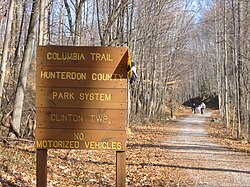Columbia Trail
| Columbia Trail | |
|---|---|

Columbia Trail in Clinton Township, New Jersey
|
|
| Length | 15.0 mi (24 km) |
| Location | Hunterdon County & Morris County |
| Trailheads | Main Street in High Bridge, Bartley Road in Washington Township |
| Use | Hiking, Cycling |
| Hiking details | |
| Trail difficulty | Easy |
| Season | Year round |
| Surface | Stone dust |
| Right of way | Central Railroad of New Jersey |
The Columbia Trail is a rail trail in rural northwestern New Jersey. It was created from portions of the former Central Railroad of New Jersey High Bridge Branch and stretches from High Bridge, in Hunterdon County, through Washington Township, in Morris County for a total of 16.2 miles (26.1 km). The trail surface is relatively flat and consists mostly of fine crushed stone.
Lewis H Taylor, a member of the trustees of the Central Jersey Railroad, brought the railroad to High Bridge in 1876. The branch line was originally built to transport coal and iron ore from mines in Morris County for use in the Taylor Wharton Iron and Steel Company, the oldest foundry in United States History, and other foundries at High Bridge or Wharton. The High Bridge Branch was also used for passenger traffic until 1935.
In 1976, the branch was deemed redundant by its new owner, Conrail, and the rails were dismantled in 1980. In the mid-1990s, Columbia Gas Company bought the trail right-of-way and laid an underground gas pipeline under the right-of-way along the length of the trail. The trail and bridges were resurfaced in 2004. Since then, it has been a recreational trail serving the surrounding communities.
The Hunterdon County Division of Parks and Recreation and Morris County Park Commission now operate and maintain the trail under lease, although ownership of the right-of-way remains with the Columbia Gas Company.
A train wreck occurred on the Ken Lockwood Gorge trestle on April 18, 1885. An iron ore train led by the coincidentally named Columbia Engine derailed on the trestle and crashed into the river below.Iron Mine Railroads of Northern New Jersey, by Larry Lowenthal, indicates this was engine 112 and does not indicate it had a name. A contemporary account of the wreck in the Iron Era newspaper does not cite a name, only the engine number. If the locomotive had a name it's probable it would have been mentioned in those days. The trail is, instead, most likely named for the Columbia Gas Pipeline. Minutes of meetings in Hunterdon Parks indicate that Hunterdon suggested the name "Columbia Trail", much to the satisfaction of the gas company. Recent oppositions to gas utilities, and their relationship to hydraulic fracturing (aka "Fracking") have spurred public outcry to rename the route "High Bridge Branch Trail", a more historically accurate and less controversial tag. Furthermore, it may be considered a conflict of interest for a government agency to promote a private industry such as Columbia Gas in name and associated publications (tax payer funded maps, guides, interpretive signage, etc.).
...
Wikipedia
